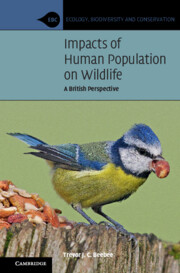Book contents
- Impacts of Human Population on Wildlife
- Ecology, Biodiversity and Conservation
- Impacts of Human Population on Wildlife
- Copyright page
- Dedication
- Contents
- Preface
- Acknowledgements
- Abbreviations
- 1 Population Matters
- 2 The State of British Wildlife
- 3 Human Activities Directly Killing Wildlife
- 4 Impacts of Development on Wildlife Declines
- 5 Impacts of Farming and Forestry on Wildlife Declines
- 6 Climate Change, Disease and Disturbance
- 7 The Human Population and Wildlife in Britain and Western Europe
- 8 Public Perceptions of Wildlife and Population Issues
- 9 International Aspects of Population Growth
- 10 Conservation in a Crowded Country
- References
- Index
1 - Population Matters
Published online by Cambridge University Press: 09 June 2022
- Impacts of Human Population on Wildlife
- Ecology, Biodiversity and Conservation
- Impacts of Human Population on Wildlife
- Copyright page
- Dedication
- Contents
- Preface
- Acknowledgements
- Abbreviations
- 1 Population Matters
- 2 The State of British Wildlife
- 3 Human Activities Directly Killing Wildlife
- 4 Impacts of Development on Wildlife Declines
- 5 Impacts of Farming and Forestry on Wildlife Declines
- 6 Climate Change, Disease and Disturbance
- 7 The Human Population and Wildlife in Britain and Western Europe
- 8 Public Perceptions of Wildlife and Population Issues
- 9 International Aspects of Population Growth
- 10 Conservation in a Crowded Country
- References
- Index
Summary
The history of recent wildlife extinctions and the widespread role of humans in these events are described. Conflicting views about the role of human numbers in wildlife declines are cited. There follows an outline of the book structure, highlighting the major proximal causes of declines in Britain , including persecution, urbanisation, agricultural intensification, climate change and disease, as detailed in subsequent chapters. There are also chapters on population growth, people's perceptions of population size and the implications for conservation A comparison of population densities in a range of countries reveals that the UK, especially England, has one of the highest densities in the world. The UK therefore provides an ideal study to investigate the impacts of human numbers on wildlife declines.
- Type
- Chapter
- Information
- Impacts of Human Population on WildlifeA British Perspective, pp. 1 - 12Publisher: Cambridge University PressPrint publication year: 2022

